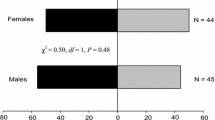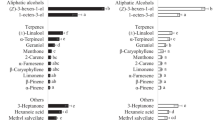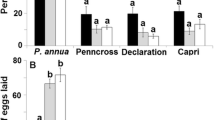Abstract
Aspects of the chemical ecology of the black-banded oak borer, (BBOB) Coroebus florentinus (Coleoptera: Buprestidae), were studied. Odors produced by males and females were similar, both qualitatively and quantitatively. Nonanal, decanal, and geranylacetone, identified in the headspace of both sexes, elicited strong electroantennographic responses from male antennae, but not from female antennae. In dual-choice olfactometer experiments, a blend of these three compounds was attractive to both sexes; males responded to decanal alone, while females responded to geranylacetone alone, suggesting that these compounds are responsible for activity of the blend to the respective sexes. Antennae of both sexes responded electroantennographically to the green leaf volatiles (E)-2-hexenal, (E)-2-hexenol, 1-hexanol, (Z)-3-hexenyl acetate, and n-hexyl acetate, all identified from the host plant Quercus suber. In behavioral experiments, only females were attracted to host-plant odors, and in tests with synthetic compounds, females were attracted to (E)-2-hexenol, 1-hexanol, and (Z)-3-hexenyl acetate. It is likely that these compounds play a role in foraging and/or oviposition behavior of BBOB females.







Similar content being viewed by others
References
Adams, P. R. 2007. pp. 804, Identification of Essential Oil Components by Gas Chromatography/mass spectrometry. Allured Publishing Corporation, Carol Stream, Illinois, USA.
Bartelt, R. J., Cosse, A. A., Zilkowski, B. W., and Fraser, I. 2007. Antennally active macrolide from the emerald ash borer Agrilus planipennis emitted predominantly by females. J. Chem. Ecol. 33:1299–1302.
Belahbib, N., Pemonge, M. H., Ouassou, A., Sbay, H., Kremer, A., and Petit, R. J. 2001. Frequent cytoplasmic exchanges between oak species that are not closely related: Quercus suber and Q. ilex in Morocco. Mol. Ecol. 10:2003–2012.
Borges, J. G., Oliveira, A. C., and Costa, M. A. 1997. A quantitative approach to cork oak forest management. For. Ecol. Manag. 97:223–229.
Carlson, R. W. and Knight, F. B. 1969. Biology, taxonomy and evolution of four sympatric Agrilus beetles (Coleoptera: Buprestidae). Contrib. Am. Ent. Inst. 4:1–105.
Crook, D. J., Kerr, L. M., and Mastro, V. C. 2008. Distribution and fine structure of antennal sensilla in emerald ash borer (Coleoptera: Buprestidae). Ann. Entomol. Soc. Am. 101:1103–1111.
Crook, D. J. and Mastro, V. C. 2010. Chemical ecology of the emerald ash borer, Agrilus planipennis. J. Chem. Ecol. 36:101–112.
De Groot, P., Grant, G. G., Poland, T. M., Scharbach, R., Buchan, L., Nott, R. W., Macdonald, L., and Pitt, D. 2008. Electrophysiological response and attraction of emerald ash borer to green leaf volatiles (GLVs) emitted by host foliage. J. Chem. Ecol. 34:1170–1179.
Francese, J. A., Oliver, J. B., Fraser, I., Lance, D. R., Youssef, N., Sawyer, A. J., and Mastro, V. C. 2008. Influence of trap placement and design on capture of the emerald ash borer (Coleoptera: Buprestidae). J. Econ. Entomol. 101:1831–1835.
Francke, W. and Dettner, K. 2005. Chemical signaling in beetles. Top. Curr. Chem. 240:85–166.
Grant, G. G., Ryall, K. L., Lyons, D. B., and Abou-Zaid, M. M. 2010. Differential response of male and female emerald ash borers (Col., Buprestidae) to (Z)-3-hexenol and manuka oil. J. Appl. Entomol. 134:26–33.
Grant, G. G., Poland, T. M., Claramitaro, T., Lions, D. B., and Jones, G. C. 2011. Comparison of male and female emerald ash borer (Coleoptera: Buprestidae) responses to phoebe oil and (Z)-3-hexenol lures in light green prism traps. For. Entomol 104:173–179.
Gwynne, D. T. and Rentz, D. C. F. 1983. Beetles on the bottle: male buprestids mistake stubbies for females (Coleoptera). J. Aust. Entomol. Soc. 22:79–80.
Hatanaka, A., Kajiwara, T., and Sekiya, J. 1987. Biosynthetic pathway for C6 aldehyde formation from linolenic acid in green leaves. Chem. Phys. Lipids 44:341–361.
Kesselmeier, J. and Staudt, M. 1999. Biogenic volatile organic compounds (VOC): An overview on emission, physiology and ecology. J. Atmos. Chem. 33:23–88.
Lelito, J. P., Fraser, I., Mastro, V. C., Tumlinson, J. H., Boeroeczky, K., and Baker, T. C. 2007. Visually mediated 'paratrooper copulations' in the mating behavior of Agrilus planipennis (Coleoptera: Buprestidae), a highly destructive invasive pest of North American ash trees. J. Insect Behav. 20:537–552.
Lelito, J. P., Fraser, I., Mastro, V. C., Tumlinson, J. H., and Baker, T. C. 2008. Novel visual-cue-based sticky traps for monitoring of emerald ash borer, Agrilus planipennis (Col., Buprestidae). J. Appl. Entomol. 132:668–674.
Lelito, J. P., Boeroczky, K., Jones, T. H., Fraser, I., Mastro, V. C., Tumlinson, J. H., and Baker, T. C. 2009. Behavioral evidence for a contact sex pheromone component of the emerald ash borer, Agrilus planipennis Fairmaire. J. Chem. Ecol. 35:104–110.
Lombardero, M. J., de Ana, F., and Magán, F. J. 1996. Distribución y daños de Coroebus florentinus (HERBST) (COL., BUPRESTIDAE) en Galícia (NO de la Península Ibérica). Ecologia 10:499–508.
Loreto, F. 2002. Distribution of isoprenoid emitters in the Quercus genus around the world: Chemo-taxonomical implications and evolutionary considerations based on the ecological function of the trait. Perspect. Plant Ecol. Evol. Syst. 5:185–192.
Manos, P. S., Doyle, J. J., and Nixon, K. C. 1999. Phylogeny, biogeography and processes of molecular differentiation in Quercus subgenus quercus (Fagaceae). Mol. Phylogenet. Evol. 12:333–349.
McIntosh, R. L., Katinic, P. J., Allison, J. D., Borden, J. H., and Downey, D. L. 2001. Comparative efficacy of five types of trap for woodborers in the Cerambycidae, Buprestidae and Siricidae. Agric. For. Entomol. 3:113–120.
Montgomery, M. E. and Wargo, P. M. 1983. Ethanol and other host-derived volatiles as attractants to beetles that bore into hardwoods. J. Chem. Ecol. 9:181–190.
Paré, P. W. and Tumlinson, J. H. 1996. Plant volatile signals in response to herbivore feeding. Fla. Entomol. 79:93–103.
Reinecke, A., Ruther, J., Tolasch, T., Francke, W., and Hilker, M. 2002. Alcoholism in cockchafers: Orientation of male Melolontha melolontha towards green leaf alcohols. Naturwissenschaften 89:265–269.
Rodriguez-Saona, C., Poland, T. M., Miller, J. R., Stelinski, L. L., Grant, G. G., de Groot, P., Buchan, L., and MacDonald, L. 2006. Behavioral and electrophysiological responses of the emerald ash borer, Agrilus planipennis, to induced volatiles of Manchurian ash, Fraxinus manchurica. Chemoecology 16:75–86.
Sabelis, M. W. and van de Baan, H. E. 1983. Location of distant spider mite colonies by phytoseid predators: demonstration of specific kairomones emitted by Tetranychus urticae and Panonychus ulmi. Entomol. Exp. Appl. 33:303–314.
Siljander, E., Gries, R., Khaskin, G., and Gries, G. 2008. Identification of the airborne aggregation pheromone of the common bed bug, Cimex lectularius. J. Chem. Ecol. 34:708–718.
Silk, P. J., Ryall, K., Lyons, D. B., Sweeney, J., and Wu, J. 2009. A contact sex pheromone component of the emerald ash borer Agrilus planipennis Fairmaire (Coleoptera: Buprestidae). Naturwissenschaften 96:601–608.
Silk, P. J., Ryall, K., Mayo, P., Lemay, M. A., Grant, G., Crook, D., Cossé, A., Fraser, I., Sweeny, J. D., Lions, D. B., Pitt, D., Scarr, T., and Magee, D. 2011. Evidence for a volatile pheromone in Agrilus planipennis Fairmaire (Coleoptera: Buprestidae) that increases attraction to a host foliar volatile. J. Chem. Ecol 40:904–916.
Soria, F. J., Villagrán, M., and Ocete, M. E. 1992. Estudios poblacionales sobre Coroebus undatus (Fabricius) (Coleoptera, Buprestidae) en alcornocales de Andalucía Occidental. I: Relación infestación-bosque. Bol. San. Veg. Plagas 18:377–383.
Soria, F. J. and Ocete, M. E. 1993. Estudios poblacionales sobre Coroebus florentinus (Herbst) (Col. Buprestidae) en alcornocales andaluces. Bol. San. Veg. Plagas 19:27–35.
Staudt, M., Mir, C., Joffre, R., Rambal, S., Bonin, A., Landais, D., and Lumaret, R. 2004. Isoprenoid emissions of Quercus spp. (Q. suber and Q. ilex) in mixed stands contrasting in interspecific genetic introgression. New Phytol 163:573–584.
Svensson, G. P., Okamoto, T., Kawakita, A., Goto, R., and Kato, M. 2010. Chemical ecology of obligate pollination mutualisms: testing the ‘private channel’ hypothesis in the Breyna-Epicephala association. New Phytol. 186:995–1004.
Takabayashi, J., Dicke, M., and Posthumus, M. A. 1996. Volatile herbivore-induced terpenoids in plant-mite interactions: Variation caused by biotic and abiotic factors. J. Chem. Ecol. 20:1329–1354.
Torto, B., Suazo, A., Alborn, H., Tumlinson, J. H., and Teal, P. E. A. 2005. Response of the small hive beetle (Aethina tumida) to a blend of chemicals identified from honeybee (Apis mellifera) volatiles. Apidologie 36:523–532.
van den Dool, J. and Kratz, P. D. 1963. A generalization of the retention index system including linear programmed gas–liquid partition chromatography. J. Chromatogr. 11:463–463.
Zar, J. H. 1999. pp. 663, Biostatistical Analysis. Prentice Hall, New Jersey.
Zhang, A., Robbins, P. S., Averill, A. L., Weber, D. C., Linn, C. E., Roelofs, W. L., and Villani, M. G. 2003. Identification of the female-produced sex pheromone of the scarab beetle, Hoplia equina. J. Chem. Ecol. 29:1635–1642.
Acknowledgements
We gratefully acknowledge Ministerio de Medio Ambiente y Medio Rural y Marino for financial support (Encomienda de Gestión Ministerio de Medio Ambiente-CSIC, 2006–2010). We also thank Generalitat de Catalunya for a FI fellowship to B.F., Lourdes Muñoz (IQAC, CSIC) for synthesis of isopropyl n-dodecanoate, Josep M. Riba (Servei Gestió Forestal, Generalitat de Catalunya), and Antonio Torrell (Forestal Catalana, Generalitat de Catalunya) for help and advice in the collection of BBOB specimens in Catalunya, and Eduardo Pérez-Laorga (Servicio de Prevención de Incendios y Sanidad Forestal, Generalitat Valenciana) and Miguel Prieto and Eudaldo Gonzalez (Servicio de Sanidad Forestal y Equilibrios Biológicos, MARM) for providing specimens from Valencia and Madrid, respectively. We also are indebted to Manuel Zarzo (Univ. Politécnica de Valencia) for statistical advice, Gerardo Sánchez (Servicio de Sanidad Forestal y Equilibrios Biológicos, MARM) for coordination of the project, Belén Torres for logistical and administrative support, and Mariano Rojo (Departament de Medi Ambiente, Generalitat de Catalunya) for continuous support and encouragement.
Author information
Authors and Affiliations
Corresponding author
Rights and permissions
About this article
Cite this article
Fürstenau, B., Rosell, G., Guerrero, A. et al. Electrophysiological and Behavioral Responses of the Black-Banded Oak Borer, Coroebus florentinus, to Conspecific and Host-Plant Volatiles. J Chem Ecol 38, 378–388 (2012). https://doi.org/10.1007/s10886-012-0110-1
Received:
Revised:
Accepted:
Published:
Issue Date:
DOI: https://doi.org/10.1007/s10886-012-0110-1




